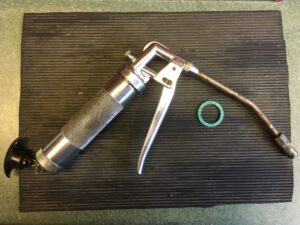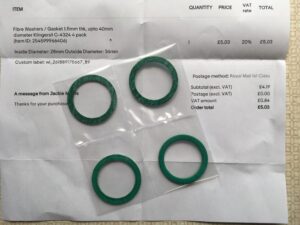Brand new grease guns are relatively inexpensive these days, but they tend to be quite large and unwieldy for smaller jobs; they are large as they are normally refilled using long plastic cartridges of grease.
Medium sized vintage grease guns made by the likes of Enots, Tecalemit, Wanner and Rom Pom are available at autojumbles and of course on eBay; I use them for work on vintage motorcycles. As they are usually covered in grease, condition is generally reasonable, and they can normally be repaired and / or refurbished. You will find both lever and pump action styles available.
The first step, once you’ve found the grease gun of your dreams, is to dismantle it completely and clean everything in petrol. Note: petrol is highly flammable, so take the necessary precautions and do it outside. Any large quantity of old grease is best removed with the plunger on the grease gun. Once dismantled, you should be able to force any lumps of grease out using the plunger. Be careful you don’t lose any small parts or the ball bearing from the grease non-return valve.
Keep the old grease! It’s normally very stiff but is ideal for ‘gluing’ screws to screwdrivers when you need to get them into an awkward place.
After you’ve cleaned all the parts, check their condition and make sure nothing is missing. Ensure the seal on the plunger / piston is in good condition and that it makes a good seal inside the cylinder. Clean out any grease galleries with a pipecleaner and make sure the nozzle opens and closes. Reassemble the gun, smearing all the parts in new grease.
Chances are, the sealing ring for the cylinder will be missing or damaged; this is often the reason why these guns are discarded in the first place. There are various options for replacing them, dependent on the type of grease gun you have. Some people use o-rings but my Rom Pom gun, shown in the picture, used a large fibre washer. The washer was missing and it was next to impossible to stop grease leaking out of the cylinder at the top. I found suitable fibre washers on eBay and have included the invoice so you can find similar ones if needed.
Once reassembled, it’s time to reload the gun with your favourite grease. Release the piston restrainer at the bottom of the cylinder, pull it back and clip it into one of the slots on either side to hold the piston back. Unscrew the cylinder from the grease gun and begin filling it from the top; I use a rubber spatula. Fill the cylinder about two thirds full of grease, trying to keep out as much air as possible. Once filled, screw the cylinder back on the the gun body after inserting the seal.
Pull back on the piston restrainer and release it from the slot on the side. Allow the piston to push the grease up as far as possible. You’ll need to unscrew the bleed valve, the small knurled screw on my photo, and let the air out. Once there’s a flow of grease you can nip it up again. Now, squeeze the lever a few times or press the nozzle on pump action guns, until grease comes out of the nozzle.
When you aren’t using the gun, pull the piston back down the cylinder a little, using the restrainer, and clip it in one the slots at the side. This stops the constant pressure on the grease and helps prevent slow leaks.
Fixing these things really isn’t rocket science, but hopefully this will help a few people with theirs.


